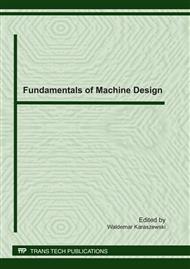[1]
British-Adopted European Standard EN-12952-3:2001, Water-tube boilers and auxiliary installations. Design and calculation of pressure parts, May-2002.
DOI: 10.3403/02574723
Google Scholar
[2]
European Standard EN-13445-3:2202, Unfired pressure vessels – Part 3: Design, May-2002.
Google Scholar
[3]
Companion Guide to the ASME Boiler and Pressure Vessel Code, K.R. Rao (Ed.), ASME Press New York, 2006.
DOI: 10.1115/1.802183
Google Scholar
[4]
R. Preiss, Stress concentration factors of flat end to cylindrical shell connection with a fillet or stress relive groove subject to internal pressure, Int. J. Press. Vessel and Piping, 73 (1997) 183-190.
DOI: 10.1016/s0308-0161(97)00067-7
Google Scholar
[5]
R. Preiss, F. Rauscher, D. Vazda, J.L. Zeman, The flat end to cylindrical shell connection – limit load and creep design, Int. J. Press. Vessel and Piping, 75 (1998) 715–726.
DOI: 10.1016/s0308-0161(97)00104-x
Google Scholar
[6]
T. Vilhelmsen, Reference stress solutions of flat end to cylindrical shell connection and comparison with design stresses predicted by codes, Int. J. Press. Vessel and Piping, 77 (2000) 35–39.
DOI: 10.1016/s0308-0161(98)00132-x
Google Scholar
[7]
S. Łaczek, J. Ryś, A.P. Zieliński, Load capacity of thick-walled cylinder with radial hole, Int. J. Press. Vessel and Piping, 87 (2010) 433-439.
DOI: 10.1016/j.ijpvp.2010.07.009
Google Scholar
[8]
G. Widłak, Local shakedown analysis of thick-walled reactor subject to mechanical and thermal loads,PhD Thesis (supervisor A.P. Zieliński), Cracow Univ. of Technology, 2010.
Google Scholar
[9]
M. Mrzygłód, A.P. Zieliński, Low-cycle fatigue constraints in two-stage structural optimization of a nozzle to pressure vessel connection, T. Burczynski, J. Periaux (Eds.), CIMNE Barcelona, 2009.
Google Scholar
[10]
B. Szybiński, A. Trojnacki, Experimental verification of strength calculations of high-pressure metal B-type sealing (in Polish), submitted to Mechanical Review (2010).
Google Scholar
[11]
P. Pedersen, Suggested benchmarks for shape optimisation for minimum stress concentration, Struct. Multidsciplinary Optim. 35 (2008), 273-283.
DOI: 10.1007/s00158-007-0148-9
Google Scholar
[12]
B. Szybiński, A. Wróblewski, Parametric optimisation of stress relief groove shape in flat ends of boilers, submitted to Journal of Strain Analysis for Eng. Design (2011).
DOI: 10.1177/0309324711421719
Google Scholar
[13]
ANSYS, ver.12.0 for research and educational purposes. Swanson Analysis Systems, 2010.
Google Scholar
[14]
Information on http://www.hbm.com.
Google Scholar


